China 2002 "Museums of China"
| <prev | back to index | next> |
| Issue Date | 09.11.2002 |
| ID | Michel: 3405-3409 Scott: Stanley Gibbons: Yvert: UPU: N/A Category: Ot |
| Author | |
| Stamps in set | 5 |
| Value | 80 cents Tianjin Natural History Museum 80 cents Shaanxi History Museum 80 cents Shanghai Museum 80 cents Henan Museum 80 cents Tibet Museum |
| Size (width x height) | |
| Layout | |
| Products | FDC x2 MCx5 |
| Paper | |
| Perforation | 13x12 |
| Print Technique | |
| Printed by | |
| Quantity | |
| Issuing Authority |
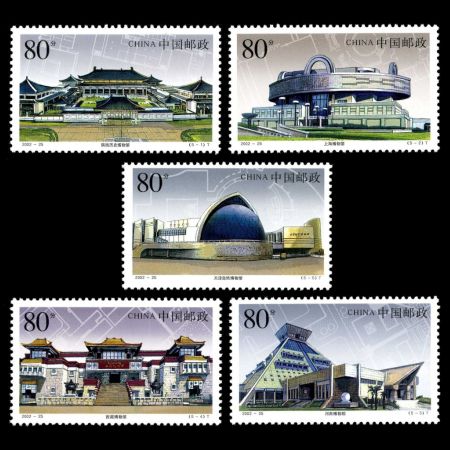
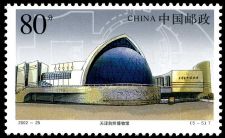 |
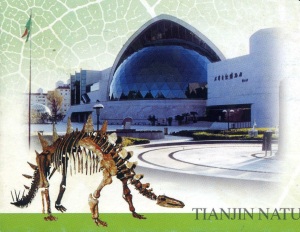 |
The Tianjin
Natural History Museum, located at the west end of the
Machang Road,
was set up in 1914 by a French missionary and opened in 1927, with the
previous name as Beijiang Museum. It got the present name in 1957. The
museum is specialized in collections of paleontology and
paleo-anthropology fossils.
Specimens total 380,000, and the key
collections show the paleontology
group in the late period of Chinese
Cenozoic Era, including fossils of ancient mammals excavated from the
Yushe Basin of Shanxi Province, the Qingyang Basin of Gansu Province,
the Yang Yuanni Basin of Hebei Province and the Inner Mongolia - the
abundance of paleontology groups of the four places are rare worldwide,
which are important
References for researches on the evolvement of amniotes. The museum
features four basic displays of Animal, Paleontology, Plants and
Paleo-anthropology fossils, containing ancient reptiles and mammals,
animal ecology, insects and aquatic organisms.
Other museums are:
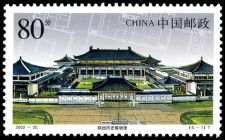 The
Shaanxi History Museum is situated on Yan Ta Road in Xi'an
City,
Shaanxi Province. It is a national-level modernized large-scale museum,
and a grand imitation of traditional Tang dynasty buildings. Covering
an area of 65,000 square meters, with a building area of 60,000 square
meters, the museum gathers the cultural quintessence in Shaanxi, and
has represented the evolution of Chinese civilization by combining the
Chinese ancient palace and courtyard architectural style
together. The museum has collected 370,000 unearthed
historical relics treasures in Shaanxi, and visitors can appreciate the
treasures made from prehistory, Zhou to Ming and Qing Dynasties which
systematically shows the Shaanxi history from 1,150,000 years before to
A.D.1840. Exhibited in the main exhibition hall are 2,700 works of art,
with an exhibition line that extends 2,300 meters. The exhibition space
is divided into an introductory hall, permanent exhibitions, special
exhibitions, and temporary exhibitions, as well as one that has been
named the National Painting Hall.
The
Shaanxi History Museum is situated on Yan Ta Road in Xi'an
City,
Shaanxi Province. It is a national-level modernized large-scale museum,
and a grand imitation of traditional Tang dynasty buildings. Covering
an area of 65,000 square meters, with a building area of 60,000 square
meters, the museum gathers the cultural quintessence in Shaanxi, and
has represented the evolution of Chinese civilization by combining the
Chinese ancient palace and courtyard architectural style
together. The museum has collected 370,000 unearthed
historical relics treasures in Shaanxi, and visitors can appreciate the
treasures made from prehistory, Zhou to Ming and Qing Dynasties which
systematically shows the Shaanxi history from 1,150,000 years before to
A.D.1840. Exhibited in the main exhibition hall are 2,700 works of art,
with an exhibition line that extends 2,300 meters. The exhibition space
is divided into an introductory hall, permanent exhibitions, special
exhibitions, and temporary exhibitions, as well as one that has been
named the National Painting Hall.
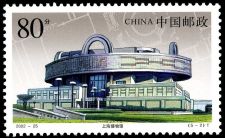 Shanghai Museum.
Shanghai Museum.
As a museum of ancient Chinese art, Shanghai Museum possesses a collection of 120,000 precious works of art. Its rich and high-quality collection of ancient Chinese bronze, ceramics, painting and calligraphy is specially celebrated in the world.
Founded and first open to the public in the building previously of the horseracing club at 325 W. Nanjing Road in 1952 and then moved into the former Zhonghui Building at 16 S. Henan Road in 1959, the museum developed very quickly in aspects of acquisition, conservation, research, exhibition, education and cultural exchanges with other institutes. In 1992, the Shanghai municipal government allocated to the Museum a piece of land at the very center of the city, the People's Square, as its new site. The whole construction took three years, from August 1993 to its inauguration on October 12th, 1996. The 29.5 meters high new building has a construction space of 39,200 square meters. Its unique architectural form of a round top with a square base, symbolizing the ancient Chinese philosophy that the square earth is under the round sky, is a distinguished architectural combination of traditional feature and modern spirit. The present Shanghai Museum has eleven galleries and three special temporary exhibition halls. It extends warm welcome to the visitors from all over the world.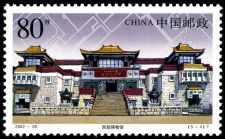 The
Tibet Museum is located in the southeast corner of Norbu
Lingka, Lhasa
city. It covers an area of 23,508 square meters (5.8 acres) including
the exhibition area of 10,451 square meters (2.6 acres). The museum is
equipped with modern facilities to ensure quality service for visitors
and safety and efficient administration of the museum itself. Here
exhibits are introduced in Japanese, English, Tibetan, and Chinese, in
order to accommodate visitors from all over the world. The
construction project of the Tibet Museum was listed as one of the
sixty-two "Aid-Tibet Projects" in July 1994.The museum opened in
October 1999 to coincide with the 50th anniversary of the Founding of
the People's Republic of China and the 40th anniversary of Tibet's
Democratic Reform. The former Chinese chairman Jiang Zemin inscribed
the named for the Museum. The museum building is a pioneering
institution in the history of Tibet. Designed by a Han Chinese
architect from Sichuan province, the complex is a wonderful combination
of Chinese and Tibetan architectural styles.
The
Tibet Museum is located in the southeast corner of Norbu
Lingka, Lhasa
city. It covers an area of 23,508 square meters (5.8 acres) including
the exhibition area of 10,451 square meters (2.6 acres). The museum is
equipped with modern facilities to ensure quality service for visitors
and safety and efficient administration of the museum itself. Here
exhibits are introduced in Japanese, English, Tibetan, and Chinese, in
order to accommodate visitors from all over the world. The
construction project of the Tibet Museum was listed as one of the
sixty-two "Aid-Tibet Projects" in July 1994.The museum opened in
October 1999 to coincide with the 50th anniversary of the Founding of
the People's Republic of China and the 40th anniversary of Tibet's
Democratic Reform. The former Chinese chairman Jiang Zemin inscribed
the named for the Museum. The museum building is a pioneering
institution in the history of Tibet. Designed by a Han Chinese
architect from Sichuan province, the complex is a wonderful combination
of Chinese and Tibetan architectural styles.
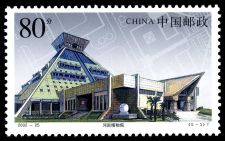 Henan
Museum, located in Zhengzhou, is a newly-built modern
history and art
museum. It opened to the public on May 1, 1998. Henan Museum occupies
an area of more than 100,000 square meters, with a total floor space of
78,000 square meters. At present the museum has a collection of more
than 130,000 pieces of cultural relics treasures, of which more than
5,000 pieces are treasures of the first and second grades. Among them,
the prehistoric cultural relics, bronze vessels of the Shang and Zhou
Dynasties, and pottery and porcelain wares of the various dynasties in
Chinese history possess most distinguishing features. Inside the
museum, there are basic exhibition halls, specialized exhibition halls
and provisional exhibition halls. For the first batch of exhibitions,
two basic displays and six specialized displays are offered. They are
rich in contents, presenting a spectacular sight to
visitors. Modern technological means have been
adopted, such as audio tour, magnified video-tape playing, computer
consultation and visitors' interactive facilities, so as to meet the
needs of visitors for knowledge and appreciation of cultural relics and
for entertainment. As a modern museum, Henan Museum is
equipped with advanced security system, automatic building management
system, audio-visual education system, service information computer
network system, cultural relics preservation, protection and research
system and other high technology equipment. Henan Museum is a
modern base for cultural relics collection, exhibition, preservation,
research, dissemination and education.
Henan
Museum, located in Zhengzhou, is a newly-built modern
history and art
museum. It opened to the public on May 1, 1998. Henan Museum occupies
an area of more than 100,000 square meters, with a total floor space of
78,000 square meters. At present the museum has a collection of more
than 130,000 pieces of cultural relics treasures, of which more than
5,000 pieces are treasures of the first and second grades. Among them,
the prehistoric cultural relics, bronze vessels of the Shang and Zhou
Dynasties, and pottery and porcelain wares of the various dynasties in
Chinese history possess most distinguishing features. Inside the
museum, there are basic exhibition halls, specialized exhibition halls
and provisional exhibition halls. For the first batch of exhibitions,
two basic displays and six specialized displays are offered. They are
rich in contents, presenting a spectacular sight to
visitors. Modern technological means have been
adopted, such as audio tour, magnified video-tape playing, computer
consultation and visitors' interactive facilities, so as to meet the
needs of visitors for knowledge and appreciation of cultural relics and
for entertainment. As a modern museum, Henan Museum is
equipped with advanced security system, automatic building management
system, audio-visual education system, service information computer
network system, cultural relics preservation, protection and research
system and other high technology equipment. Henan Museum is a
modern base for cultural relics collection, exhibition, preservation,
research, dissemination and education.Products
| FDC: official covers on the left, personalized one on the right side | |
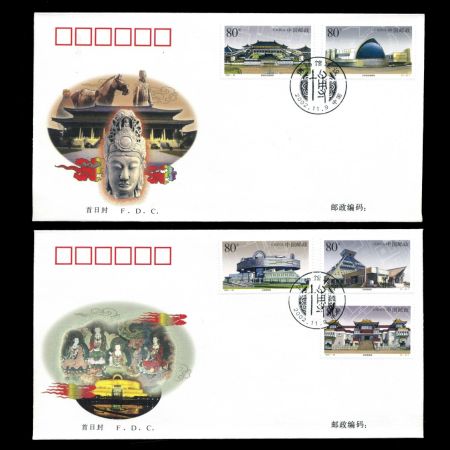 |
 |
| Maxi Cards | Used Cover |
 |
 |
References
ChinaCultur.org| <prev | back to index | next> |